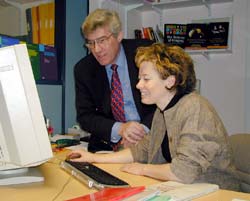
A new type of star has been discovered lurking as a low mass component in a very compact binary star system.
Astronomers Steve B. Howell of the University of California, Riverside and Tom Harrison of New Mexico State University, Las Cruces, announced today at the American Astronomical Society Meeting in Seattle, Wash., that they have confirmed the existence of a new variety of stellar end-product. This previously unknown type of star has some properties similar to brown dwarf stars and may

University of Georgia researchers studying rice genomes under a National Science Foundation Plant Genome Research Program award have identified the species’ first active DNA transposons, or “jumping genes.” The research is published in the Jan. 9 edition of the journal Nature. In collaboration with researchers from Cornell, Washington University and Japan, geneticist Susan Wessler also discovered the first active “miniature inverted-repeat transposable element,” or “MITE,” of a

Which way does a mammoth skeleton point in Siberia? No, it’s not a Christmas cracker joke. To find the answer you have to look in a rather surprising place – the Institute of Physics’ new online archive.
In an article published in the first edition of Proceedings of the Physical Society in 1874, John Rae writes about the physical properties of ice and mammoth remains. He put forward a theory as to why so many of the mammoth skeletons found near the Yenesei river in Siberia had been found wi

Whether you fancy yourself a jet-setting sophisticate or a down-to-earth outdoorsy type, a fast-track corporate star or an all-around nice guy, new research indicates that you probably tune out information that challenges your self-image by tuning in to television.
The findings, by Sophia Moskalenko of the University of Pennsylvania and Steven Heine of the University of British Columbia, are presented in a paper published in the January issue of the Personality and Social Psychology Bulletin.

In three separate studies, scientists at the University of North Carolina at Chapel Hill School of Medicine have shown that it is possible to correct defective molecular splicing pathways that would otherwise contribute to cancer, genetic diseases and possibly other disorders.
These corrections were accomplished by the insertion into the cell of antisense oligonucleotides, short strands of genetic material that target portions of RNA. RNA carries the DNA blueprint for cellular protein produ

A 12-year study of 38,077 male health professionals found that men who drank alcohol three or more days per week had a reduced risk of heart attack compared with men who drank less frequently. Men who drank less than one drink a day had similar risk reduction to those who drank three.
Many epidemiologic studies have reported that moderate drinking–for men two drinks a day–is associated with a reduced risk of heart disease. This study looked at the relationship between quantity and frequen

– new calculation confirms standard model of particle physics. Contribution of hadronic vacuum polarization determined with unprecedented accuracy. The magnetic moment of the muon is an important precision parameter for…
Technique may prevent formation of unwanted waves that siphon off needed energy. Heating plasma to the ultra-high temperatures needed for fusion reactions requires more than turning the dial on a…

An international team of astronomers, led by researchers from the Astronomical Observatory of the University of Warsaw, have identified a new class of cosmic X-ray sources. The findings have been…

How deubiquitinases USP53 and USP54 cleave long polyubiquitin chains and how the former is linked to liver disease in children. Deubiquitinases (DUBs) are enzymes used by cells to trim protein…

Conceptual blueprint to analyze experimental catalyst data. Machine learning (ML) models have recently become popular in the field of heterogeneous catalyst design. The inherent complexity of the interactions between catalyst…

Antibody that Neutralizes Inhibitory Factors Involved in Nerve Regeneration Leads to Enhanced Motor Function after Acute Spinal Cord Injury. Researchers at 13 clinics in Germany, Switzerland, the Czech Republic and…

How simulations help manufacturing of modern displays. Modern materials must be recyclable and sustainable. Consumer electronics is no exception, with organic light-emitting diodes (OLEDs) taking over modern televisions and portable…

“Neurons that fire together, wire together” describes the neural plasticity seen in human brains, but neurons grown in a dish don’t seem to follow these rules. Neurons that are cultured…

The quest for sustainable energy solutions has been a major focus of scientific research for decades. Solar energy, a clean and renewable source, has emerged as a promising alternative to…

With a processing speed a billion times faster than nature, chip-based laser neuron could help advance AI tasks such as pattern recognition and sequence prediction. Researchers have developed a laser-based…

New technology could remotely identify various types of plastics, offering a valuable tool for future monitoring and analysis of oceanic plastic pollution. Researchers have developed a new hyperspectral Raman imaging…

Artificial Intelligence (AI) has established a strong presence across industries, large and small. The “VoBaKI” research project has empowered small and medium-sized enterprises (SMEs) with an innovative tool to independently…